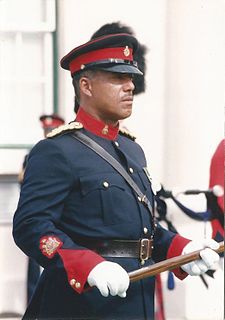
The Armed Forces of the Philippines (AFP) are the military forces of the Philippines. It consists of three main service branches; the Army, the Air Force, and the Navy. The President of the Philippines is the Commander-in-Chief of the AFP and forms military policy with the Department of National Defense, an executive department acting as the principal organ by which military policy is carried out, while the Chairman of the Joint Chiefs serves as the overall commander and the highest-ranking officer in the AFP. The Philippine Coast Guard also serves as an attached service of the AFP in wartime. Military service is entirely voluntary.

Warrant officer (WO) is a rank or category of ranks in the armed forces of many countries. Depending on the country, service, or historical context, warrant officers are sometimes classified as the most junior of the commissioned ranks, the most senior of the non-commissioned officer (NCO) ranks, or in a separate category of their own. Warrant officer ranks are especially prominent in the militaries of Commonwealth nations and the United States.
A lieutenant is a junior commissioned officer in the armed forces, fire services, police and other organizations of many nations.

A non-commissioned officer (NCO) is a military officer who has not earned a commission. Non-commissioned officers usually obtain their position of authority by promotion through the enlisted ranks. In contrast, commissioned officers usually enter directly from a military academy, Officer Candidate School (OCS), or Officer Training School (OTS) after receiving a post-secondary degree.

Sergeant is a rank in many uniformed organizations, principally military and policing forces. The alternative spelling, serjeant, is used in The Rifles and other units that draw their heritage from the British light infantry. Its origin is the Latin serviens, 'one who serves', through the French term sergeant.
Corporal is a military rank in use in some form by many militaries and by some police forces or other uniformed organizations. Within NATO, each member nation's corresponding military rank of corporal is combined under the NATO-standard rank scale code OR-3 or OR-4. However, there are often differences in how each nation employs corporals. Some militaries do not have corporals, but may instead have a junior sergeant.
Staff sergeant is a rank of non-commissioned officer used in the armed forces of many countries. It is also a police rank in some police services.
A master sergeant is the military rank for a senior non-commissioned officer in the armed forces of some countries. This is a NATO ranking.
Sergeant major is a senior non-commissioned rank or appointment in many militaries around the world. In Commonwealth countries, the various degrees of sergeant major are appointments held by warrant officers. In the United States, there are also various grades of sergeant major, all of the same pay grade of E-9; however, the Sergeant Major of the Army and the Sergeant Major of the Marine Corps, as their respective service's Senior Enlisted Advisor, receive a special rate of basic pay that is higher than all other sergeants major.
A chief petty officer is a senior non-commissioned officer in many navies and coast guards.
Technical sergeant is the name of two current and two former enlisted ranks in the United States Armed Forces. Outside the United States, it is used only by the Philippine Army, Philippine Air Force and the Philippine Marine Corps.
Chief Master Sergeant (CMSgt) is the ninth, and highest, enlisted rank in the U.S. Air Force and the U.S. Space Force, just above Senior Master Sergeant, and is a senior non-commissioned officer rank. The official term is "Chief Master Sergeant" or "Chief".
Master warrant officer (MWO) is a senior military rank in the Bangladesh Armed Forces, the Canadian Forces, Singapore Armed Forces, the South African National Defence Force and the Israel Defense Forces.
The Singapore Armed Forces (SAF) has five rank schemes for active and reservist personnel, with a sixth for the auxiliaries of the SAF Volunteer Corps. The rank structure is largely unified, with identical rank insignia across the Singapore Army, Republic of Singapore Navy, and Republic of Singapore Air Force.
The naval rank of First Master Chief Petty Officer in the Armed Forces of the Philippines has been passed in a bill filed by Senator Rodolfo Biazon back in July 2004. It is expected that President Gloria Macapagal Arroyo will sign it very soon, enabling the rank to be created. The equivalent rank in the Philippine Army will be first chief master sergeant.
The following is a list of military appointments and ranks of the Myanmar Army. As a former British colonial territory, its ranks follow those of the British Army.

The military ranks of Ukraine were created in March 1992 after adopting the law of Ukraine "About Universal Military Duty and Military Service". The rank structure corresponds the generic military rank structure of the Soviet Union. Ukrainian armed forces have two styles of ranks - army, which is used by ground forces as well as aerial forces, and naval - the Ukrainian Navy.
First sergeant is typically a senior non-commissioned officer rank, used in many countries. In NATO armed forces the rank is on OR8 level.
Hauptbootsmann designates in the German Navy of the Bundeswehr a military person or member of the armed forces. It belongs to the particular rank group Senior NCOs with port épée.
The following are the ranks of officials and officers of the Philippine National Police (PNP). These men and women report to the following: